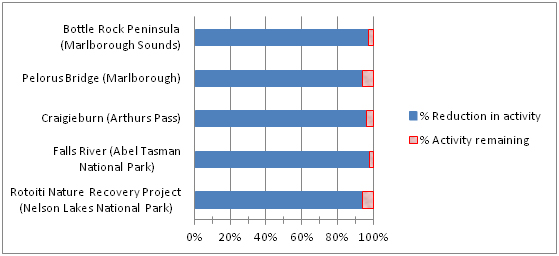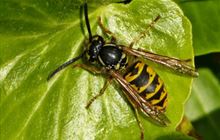Success for wasp control pilot programme
Archived content: This media release was accurate on the date of publication.
Introduction
A pilot programme to control wasps on conservation land during the summer season has led to a significant reduction in wasp activity at the pilot sites.Date: 22 June 2015
The pilot, at five sites in the South Island, involved a bait station method using a protein bait targeted only at wasps. The bait, which is not attractive to bees, contains the commonly used insecticide fipronil.
DOC developed the pilot together with BASF, a highly experienced global pest solutions company, and a Nelson based consultancy. The programme involved considerable expertise from DOC’s community based partners at each site, including Friends of Rotoiti, Project Janszoon, Forest and Bird, and Waimakariri Environment and Recreation Committee.
The results showed that there was more than 95% reduction of wasp activity in nests monitored before and after the trial. At some of the sites, the wasp nests were completely controlled when checked again one month later.
That compares with wasp activity increasing by up to 160% at non-treated sites that were monitored at the same time.
DOC Scientist Eric Edwards says as well as the reduction in wasp activity, there was also significantly more honeydew present on trees in areas where wasps were killed.
“This means there was more of this valuable energy source available to birds and insect life. Reducing wasp numbers has also allowed many species, such as spiders, beetles and caterpillars, to survive the annual wasp onslaught,” he says.
“DOC and our community based partners who were involved in the pilot are delighted these results were as anticipated. We now have a tool to help reduce the impact of wasps on our wildlife and visitors to recreation areas.”
“However, it’s important to realise that wasps are a persistent, perennial problem. They fly long distances and re-invade to build up populations again the next summer,” Eric Edwards says.
DOC still needs the science community to invest in research to look at long term integrated solutions for controlling wasps on a larger scale. A recent study by MPI and DOC showed that introduced wasps cost the New Zealand economy more than $130 million a year.
DOC will now work with key stakeholders on plans and priorities for using this tool on public conservation land next year.
Background information
The wasp baiting method was used in five pilot sites:
- Rotoiti Nature Recovery Project (Nelson Lakes – 1750 ha treated)
- Bottle Rock Peninsula (Marlborough Sounds – 450 ha treated)
- Pelorus Bridge (Marlborough – 200 ha treated)
- Falls River (Abel Tasman National Park – 750 ha treated)
- Craigieburn (Arthurs Pass – 2000 ha treated).
The average reduction in wasp activity at nests following bait station control at five sites is shown in the figure below:

Data taken from the mean count of wasps both entering and leaving (n =10) nests in 60 seconds under warm daytime conditions. Percentages are derived from counts recorded up to 5 days pre-operation and counted again 7 to 10 days post operation.
Contact
Leigh-Anne Wiig, DOC Media Advisor
Phone: +64 495 8629
Email: lwiig@doc.govt.nz


